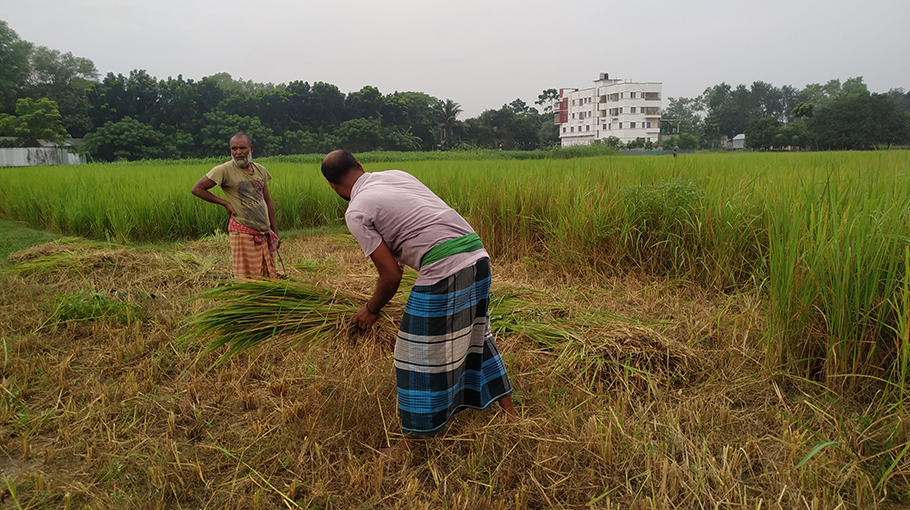Aman paddy cultivation in Chalan Beel in jeopardy


Chalan Beel consists of many small and big Beels of Pabna, Natore and Sirajganj districts. One of the major crops of this Beel area is Aman paddy. The farmers of this area used to cultivate different varieties of paddy including Ajaldigha, Dhladigha, Banshiraj and many more varities. At present, they are suffering most of the years due to hostile behavior of nature and scarcity of water. Due to natural calamities like heavy rains, lack of rains, early floods, they are suffering this loss.
The location of Chalan Beel across ten unions of Ullapara including Singra, Gurdaspur and Baraigram of Natore district, Chatmohar and Bhangura of Pabna, Tarash, Raiganj, Salanga of Sirajganj. In the past, the area of this Beel was 800 square miles. Now the size of this bill is gradually decreasing. Water management in some Beels are regulated but water management in most Beels is nature dependent. At the beginning of monsoon, water enters the Beel through the connecting canal. In unregulated Beels, some years water seeps into the Beels before the seedlings of Aman paddy grow, causing the seedlings to submerge. In some years, the Aman paddy dries up due to rapid drainage of water at the end of the rainy season. Then there was a severe yield disaster. Aman cultivation and yield are both good in some of the Beels controlled by sluice gates. However, due to lack of water and low rainfall, the desired yield is not obtained even in the relatively high Aman fields of Chalan Beel. At the beginning of the rainy season in the current season, the young paddies of Aman paddy in the lower areas are drowned and destroyed. Due to that, paddy plants are drying up and dying due to flood water not entering the higher areas. Some are cutting raw paddy saplings and using them as fodder for livestock. As a result, thousands of Aman paddy farmers in the unregulated Beel area have to bear a loss of around ten thousand Tk per bigha.
It has been found that Aman paddy is cultivated in thousands of hectares of land in Chalan Beel area. In the current season, the target for cultivation of Aman paddy in Chatmohar alone was 9,100 hectors. But at the beginning of the rainy season, the rice seedlings are destroyed due to sudden inflow of water into the banks of the lower areas. Again, due to non-rising of water in the higher areas, 2500 hectares of unripe paddy in Chatmohar is being used as fodder for cattle.
After visiting the area, many people were seen cutting raw paddy in the fields adjacent to Chatmohar municipality.
Kamal Hossain of Jaberpur village cultivated Aman paddy on lease of one and a half bigha land for ten thousand taka. There is not a drop of water in the land. There will be no paddy, so he sold the paddy trees of one and a half bigha land to the cow farmers for only 2500 taka. He will lose at least 12 thousand Tk. Abdus Salam of Kumargara village said that he sowed Ajaldigha paddy on 2 bigha land. They were cut and used as fodder for cattle. Aman farmers in several other areas are cultivating Aman seedlings after cutting Aman paddy. Azahar Ari of Chhota Shalikha village said that he cultivated Aman on 4 bigha land. If there was water, he would get at least 40 maunds of paddy which cost about 40 thousand taka. Now he is approaching cow farmers to sell Aman rice plants. Abdul Wadud of Hasmari village of Gurdaspur upazila said that due to lack of rain and necessary monsoon water, Aman paddy is getting destroyed.
Shahjahan Ali, a farmer of Kashipur village of Bhangura upazila, said that due to the presence of sluice gate in the Demra area, there will be good paddy in the controlled areas, but due to lack of sufficient water in the uncontrolled areas, the paddy plants are drying up and dying.
In this regard, Chatmohar Upazila Agriculture Officer AA Masum Billah said that the sown Aman paddy is water dependent. Due to lack of required monsoon and rainfall, paddy plants of many lands are drying up and dying. It is not possible to irrigate these lands. Some are cutting Aman paddy trees and feeding them to cattle. However, I hope that there will be good rice in some regulated Beels.

